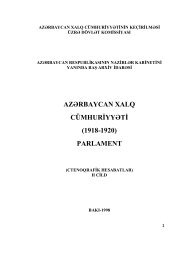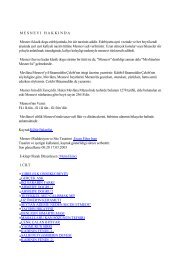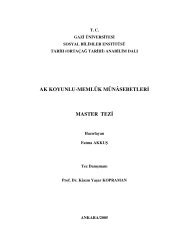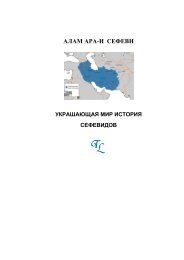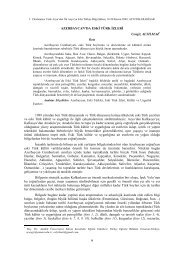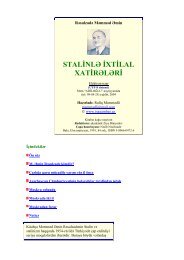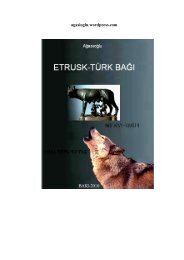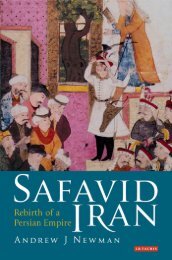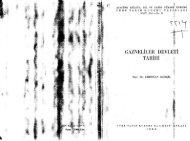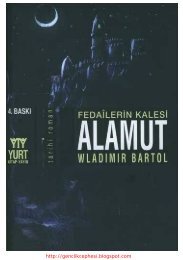Between Scylla <strong>and</strong> Charybdis 39goods over which there is competition are not unlimited, <strong>and</strong> thus one speaks ofconstra<strong>in</strong>ts bear<strong>in</strong>g on the actors <strong>in</strong> this competition. Were the means <strong>and</strong> thegoods <strong>in</strong> both arenas unlimited, politics, the science of statecraft, <strong>and</strong> economics,the science of house-hold<strong>in</strong>g, to follow Aristotle’s def<strong>in</strong>itions, would not only besuperfluous, but also mean<strong>in</strong>gless activities, <strong>and</strong> competition over plentifullyavailable goods, irrational if not <strong>in</strong>sane.5 On the question of colonialism <strong>and</strong> the colonial narrative, see Edward Said,Orientalism (New York: V<strong>in</strong>tage Books, 1978) <strong>and</strong> Culture <strong>and</strong> Imperialism (NewYork: V<strong>in</strong>tage Books, 1993).6 Popular belief associates rationality <strong>in</strong> decision-mak<strong>in</strong>g with success, thus <strong>in</strong> thecontext of the competition between Engl<strong>and</strong>, Russia, <strong>and</strong> <strong>Qajar</strong> <strong>Persia</strong> from thewan<strong>in</strong>g years of the eighteenth century to the first half of the n<strong>in</strong>eteenth century,there is never a question about Agha Mohammad Khan’s foreign policy decisionss<strong>in</strong>ce they resulted <strong>in</strong> territorial ga<strong>in</strong>s. On the other h<strong>and</strong>, lack of territorial ga<strong>in</strong>s,or worse, loss of territory, provokes scrut<strong>in</strong>y <strong>and</strong> needs justification on theassumption that failure to achieve ga<strong>in</strong>s is due to the personal shortcom<strong>in</strong>gs ofdecision-makers, or defects <strong>in</strong>ternal to the decision-mak<strong>in</strong>g process. To take <strong>in</strong>toaccount, for example, unalterable factors from the outside, <strong>in</strong>ternal pressures, orsimply luck or lack thereof, the popular m<strong>in</strong>d has little patience. It is thereforeessential before enter<strong>in</strong>g <strong>in</strong>to debates about historical outcomes to consider howtheoretical discussions might help clarify what otherwise must rema<strong>in</strong> only a bewilder<strong>in</strong>garray of data.7 Far too little attention has been paid to the question of luck or good fortune,<strong>and</strong> yet <strong>in</strong> <strong>in</strong>ternational politics chance is often a decisive factor <strong>in</strong> the outcomeof events. Machiavelli <strong>in</strong> The Pr<strong>in</strong>ce, is one of the few political th<strong>in</strong>kers who seriouslyconsiders the role of chance. He speaks of Fortuna as the counterpart to ormirror image of Necessità or Fate. For Machiavelli, fate represents the parametersor constra<strong>in</strong>ts with<strong>in</strong> which the decision-maker must operate. Fortuna representsthe opportunities that arise. A conjunction of right tim<strong>in</strong>g <strong>and</strong> good fortunemay decide the issue of the event. See also Carl von Clausewitz’ classic treatize,On <strong>War</strong>, with an <strong>in</strong>troduction by Anatol Rapoport (Harmondsworth: Pengu<strong>in</strong>,1968), on the role of chance <strong>in</strong> questions of strategy, <strong>and</strong> Joseph Nye, Jr <strong>and</strong> DavidMcCullough on chance <strong>in</strong> politics <strong>and</strong> history respectively. Nye calls his conceptualframework <strong>in</strong>corporat<strong>in</strong>g chance “counter-factuals,” a term he popularizedas a method of reach<strong>in</strong>g greater certa<strong>in</strong>ty <strong>in</strong> <strong>in</strong>ternational political analysis; see,Underst<strong>and</strong><strong>in</strong>g International Conflicts: An Introduction to Theory <strong>and</strong> History, 4thedn (New York: Longman Publishers, 2003). McCullough speaks of the role ofchance <strong>in</strong> General Wash<strong>in</strong>gton’s campaigns aga<strong>in</strong>st the British dur<strong>in</strong>g the AmericanRevolution <strong>in</strong> his recent work, 1776 (New York: Simon <strong>and</strong> Schuster, 2005).8 There is a substantial debate on the question of how national <strong>in</strong>terest is def<strong>in</strong>ed<strong>and</strong> whether or not national level decision-makers do (or do not) present personal<strong>in</strong>terests as national <strong>in</strong>terests, either by clever formulation or by forced equationsuch as Louis XIV’s statement “l’état c’est moi.” However, Machiavelli’sposition rema<strong>in</strong>s the st<strong>and</strong>ard answer to these criticisms, both dur<strong>in</strong>g his time <strong>and</strong><strong>in</strong> that of his realist heirs today.9 B. M. Russett, H. Starr <strong>and</strong> D. K<strong>in</strong>sella, World Politics: A Menu for Choice, 7th edn(Belmont, CA <strong>and</strong> London: Wadsworth, 2004), p. 161. This “ends–means”calculus is also called “<strong>in</strong>strumental rationality.”10 See Robert Jervis “The <strong>Implications</strong> of Prospect Theory for Human Nature <strong>and</strong>Values,” <strong>in</strong> Rose McDermott, ed., Political Psychology 25/2 (April 2004): 163–76.The <strong>in</strong>tricacies of the debate between rational choice theorists <strong>and</strong> prospecttheorists are beyond the scope of this paper, but the predom<strong>in</strong>ant view is thatprospect theory is a departure from rational choice as it focuses on emotion (lossaversion <strong>and</strong> fram<strong>in</strong>g) as a determ<strong>in</strong>ant of action, whereas pure rational choice
40 Manoutchehr M. Esk<strong>and</strong>ari-<strong>Qajar</strong>theories abstract from emotion to focus on a strict utility maximization pr<strong>in</strong>ciple.(For a thorough discussion see McDermott’s <strong>in</strong>troductory remarks <strong>in</strong> theabove special issue on prospect theory, pp. 147–61.) There is also a question as towhether these new formulations are ref<strong>in</strong>ements of rational decision-mak<strong>in</strong>g orsubstantial enough critiques of it to constitute departures from the theory altogether.Russett et al., op. cit., p. 166, answer that,[n]one of these challenges to the rational actor model imply that decision makersare irrational, only that actual decision mak<strong>in</strong>g departs from the idealmodel <strong>in</strong> various <strong>and</strong> significant ways. Nor do they suggest that rational choiceapproaches to the study of world politics are doomed to failure because ofthese imperfections.It is Russett et al., op. cit., p. 163, who choose the term “ref<strong>in</strong>ement” to describeprospect theory as an alternate theory of rationality. There have also been attemptsto br<strong>in</strong>g the f<strong>in</strong>d<strong>in</strong>gs of rational decision-mak<strong>in</strong>g <strong>and</strong> prospect theory closer togetheras prom<strong>in</strong>ent exponents of each camp have looked for common ground. (Seefor <strong>in</strong>stance, Bruce Bueno de Mesquita <strong>and</strong> Rose McDermott, “Cross<strong>in</strong>g NoMan’s L<strong>and</strong>: Cooperation From the Trenches,” <strong>in</strong> McDermott, op. cit. (2004),pp. 163–76).F<strong>in</strong>ally, there are questions regard<strong>in</strong>g the theoretical strength of each of these theories.(For a survey of the state of the discipl<strong>in</strong>e regard<strong>in</strong>g rationality <strong>in</strong> decisionmak<strong>in</strong>gsee Eldar Shafir <strong>and</strong> Robyn A. LeBoeuf, “Rationality,” Annual Revue ofPsychology 53 (2002): 491–5.) Two challenges to prospect theory are particularlynoteworthy: a) the apparent failure of the theory to more fully expla<strong>in</strong> the orig<strong>in</strong><strong>and</strong> causes of fram<strong>in</strong>g, <strong>and</strong> b) the <strong>in</strong>ability of the theory to dist<strong>in</strong>guish satisfactorilybetween consistency <strong>and</strong> causality (see McDermott, op. cit., pp. 154 <strong>and</strong>160). Rational decision-mak<strong>in</strong>g, on the other h<strong>and</strong>, has been criticized on the notionthat its requirements are too strict <strong>and</strong> its conditions impossible to fulfill <strong>in</strong> realworldsett<strong>in</strong>gs. Decision-mak<strong>in</strong>g theorists such as Herbert Simon therefore speakof “limited rationality” or “bounded rationality” <strong>in</strong> decision-mak<strong>in</strong>g <strong>and</strong> of thenotion of “satisfyc<strong>in</strong>g” (that is “first acceptable option” decision-mak<strong>in</strong>g) as amore appropriately descriptive theory of the actual decision-mak<strong>in</strong>g process thanpure utility maximization. See Herbert Simon, Models of Man (New York: WileyPublishers, 1957) <strong>and</strong> Models of Bounded Rationality (Cambridge: MIT Press, 1982).The idea of bounded rationality is applied to wartime decision-mak<strong>in</strong>g by ScottSigmund Garter <strong>in</strong> Strategic Assessment <strong>in</strong> <strong>War</strong> (New Haven: Yale UniversityPress, 1997), as cited <strong>in</strong> Russett, et al., op. cit., p. 163. Some have even ab<strong>and</strong>onedthe analytical framework of rational decision-mak<strong>in</strong>g altogether <strong>in</strong> favour ofdifferent approaches that they argue capture the real world of decision-mak<strong>in</strong>gprocesses better without requir<strong>in</strong>g the detachment of strict rational decisionmak<strong>in</strong>gtheory, see Thomas R. Dye, Underst<strong>and</strong><strong>in</strong>g Public Policy, 11th edn (UpperSaddle River, NJ: Pearson/Prentice Hall, 2005), chapter 2, “Models of Politics.”Graham Allison, <strong>in</strong> his l<strong>and</strong>mark formulation of the essence of decision-mak<strong>in</strong>g<strong>in</strong> 1971 (cited <strong>in</strong> Paul R. Viotti <strong>and</strong> Mark V. Kauppi, International Relations <strong>and</strong>World Politics: Security, Economy, Identity, 2nd edn (Upper Saddle River, NJ:Prentice Hall, 2001), p. 127), presents one of the most famous critiques of rationalchoice theory:where a given bureaucratic actor or diplomat st<strong>and</strong>s on a given issue is oftendeterm<strong>in</strong>ed by where he or she sits; that is, one’s view of alternative coursesof action is highly colored by the perspective of the organization to whichone belongs or role one plays. Perceptions of what is the optimal or best courseof action often vary from one bureaucratic actor to another, reflect<strong>in</strong>g
- Page 2 and 3: War and Peace in Qajar PersiaPersia
- Page 4 and 5: War and Peace inQajar PersiaImplica
- Page 6 and 7: ContentsList of figuresContributors
- Page 8 and 9: Figures5.1 Omani enclaves 1305.2 Ar
- Page 10 and 11: Contributor listMansoureh Ettehadie
- Page 12: AcknowledgementsThis volume grew ou
- Page 15 and 16: 2 Roxane Farmanfarmaianrepresented
- Page 17 and 18: 4 Roxane Farmanfarmaianchapter in t
- Page 19 and 20: 6 Roxane FarmanfarmaianThus, two si
- Page 21 and 22: 8 Roxane Farmanfarmaiangaining grea
- Page 23 and 24: 10 Roxane Farmanfarmaiantough deals
- Page 25 and 26: 12 Roxane FarmanfarmaianIranian geo
- Page 27 and 28: 14 Peter W. Averyin Shiraz and cont
- Page 29 and 30: 16 Peter W. Averybut the invasion w
- Page 32: Part IWar
- Page 35 and 36: 22 Manoutchehr M. Eskandari-Qajarth
- Page 37 and 38: 24 Manoutchehr M. Eskandari-Qajarap
- Page 39 and 40: 26 Manoutchehr M. Eskandari-Qajarmi
- Page 41 and 42: 28 Manoutchehr M. Eskandari-Qajarth
- Page 43 and 44: 30 Manoutchehr M. Eskandari-Qajardo
- Page 45 and 46: 32 Manoutchehr M. Eskandari-QajarIn
- Page 47 and 48: 34 Manoutchehr M. Eskandari-Qajarco
- Page 49 and 50: 36 Manoutchehr M. Eskandari-QajarTh
- Page 51: 38 Manoutchehr M. Eskandari-Qajarth
- Page 55 and 56: 42 Manoutchehr M. Eskandari-Qajarop
- Page 57 and 58: 44 Manoutchehr M. Eskandari-Qajarbe
- Page 59 and 60: 46 Manoutchehr M. Eskandari-Qajarva
- Page 61 and 62: 48 Stephanie Cronincapacity and res
- Page 63 and 64: 50 Stephanie Croninforces of the es
- Page 65 and 66: 52 Stephanie CroninPART ONE: THE QA
- Page 67 and 68: 54 Stephanie Croninprincipally on h
- Page 69 and 70: 56 Stephanie CroninThe French offic
- Page 71 and 72: 58 Stephanie CroninEuropean alignme
- Page 73 and 74: 60 Stephanie Croninthe authorities
- Page 75 and 76: 62 Stephanie Croninin the revolutio
- Page 77 and 78: 64 Stephanie Croninof power and sta
- Page 79 and 80: 66 Stephanie Croninliving and the m
- Page 81 and 82: 68 Stephanie Croninconsequences for
- Page 83 and 84: 70 Stephanie Croninrevolution was a
- Page 85 and 86: 72 Stephanie CroninNew British miss
- Page 87 and 88: 74 Stephanie CroninBrigade to a Div
- Page 89 and 90: 76 Stephanie Croninwithout the sove
- Page 91 and 92: 78 Stephanie Croninaccounting devic
- Page 93 and 94: 80 Stephanie Croninbut also faced a
- Page 95 and 96: 82 Stephanie Cronindetermined on th
- Page 97 and 98: 84 Stephanie Cronin15 For a discuss
- Page 99 and 100: 86 Stephanie Cronin55 The Anglo-Rus
- Page 101 and 102: 3 The Turko-Persian War1821-1823Win
- Page 103 and 104:
90 Graham WilliamsonThe resultant w
- Page 105 and 106:
92 Graham Williamsonprovincial forc
- Page 107 and 108:
94 Graham WilliamsonThe field armyO
- Page 109 and 110:
96 Graham Williamsonnot hold out mu
- Page 111 and 112:
98 Graham Williamsonoften in arrear
- Page 113 and 114:
100 Graham Williamsonthan any desig
- Page 115 and 116:
102 Graham WilliamsonThere were ove
- Page 117 and 118:
104 Graham Williamsonone should not
- Page 119 and 120:
Table 3.2 Persian regional armies (
- Page 121 and 122:
108 Graham WilliamsonIranian influe
- Page 123 and 124:
4 Social networks andborder conflic
- Page 125 and 126:
112 Vanessa MartinPersian troops on
- Page 127 and 128:
114 Vanessa Martinof comparatively
- Page 129 and 130:
116 Vanessa MartinTHE ROLE OF SOCIA
- Page 131 and 132:
118 Vanessa MartinThe Shah’s negl
- Page 133 and 134:
120 Vanessa Martinborder or any oth
- Page 135 and 136:
122 Vanessa Martin44 No. 38, 2 June
- Page 138 and 139:
5 The consolidation of Iran’sfron
- Page 140 and 141:
Consolidation of Iran’s frontier
- Page 142 and 143:
Consolidation of Iran’s frontier
- Page 144 and 145:
Consolidation of Iran’s frontier
- Page 146 and 147:
Consolidation of Iran’s frontier
- Page 148 and 149:
Consolidation of Iran’s frontier
- Page 150 and 151:
Figure 5.2 Arab principalities
- Page 152 and 153:
Consolidation of Iran’s frontier
- Page 154 and 155:
Consolidation of Iran’s frontier
- Page 156 and 157:
Consolidation of Iran’s frontier
- Page 158 and 159:
Consolidation of Iran’s frontier
- Page 160 and 161:
Consolidation of Iran’s frontier
- Page 162 and 163:
6 Narrowing the frontierMid-ninetee
- Page 164 and 165:
Narrowing the frontier 151witnessed
- Page 166 and 167:
Figure 6.1 The 1843 borderlands sta
- Page 168 and 169:
Narrowing the frontier 155And the S
- Page 170 and 171:
Figure 6.2 The 1850 Williams line a
- Page 172 and 173:
Narrowing the frontier 159elicited
- Page 174 and 175:
Narrowing the frontier 161travellin
- Page 176 and 177:
Narrowing the frontier 163be found
- Page 178 and 179:
Narrowing the frontier 165A similar
- Page 180 and 181:
Narrowing the frontier 167and accep
- Page 182 and 183:
Narrowing the frontier 169Perhaps t
- Page 184 and 185:
Narrowing the frontier 171By this s
- Page 186 and 187:
Narrowing the frontier 17346 For a
- Page 188 and 189:
Crime, security, and insecurity 175
- Page 190 and 191:
Crime, security, and insecurity 177
- Page 192 and 193:
Crime, security, and insecurity 179
- Page 194 and 195:
Crime, security, and insecurity 181
- Page 196 and 197:
8 Merchants without bordersTrade, t
- Page 198 and 199:
Merchants without frontier 185the m
- Page 200 and 201:
Merchants without frontier 187and d
- Page 202 and 203:
Merchants without frontier 189photo
- Page 204 and 205:
Merchants without frontier 191their
- Page 206 and 207:
Merchants without frontier 193In an
- Page 208 and 209:
Figure 8.1Seated, first from left:
- Page 210 and 211:
Figure 8.3Seated: Hajj Mohammad-Taq
- Page 212 and 213:
Figure 8.5 Taken in Hajj Hasan Jour
- Page 214 and 215:
Merchants without frontier 201Figur
- Page 216 and 217:
Merchants without frontier 203Studi
- Page 218 and 219:
Merchants without frontier 20516 Me
- Page 220 and 221:
Merchants without frontier 207and t
- Page 222 and 223:
Merchants without frontier 209or pu
- Page 224 and 225:
Merchants without frontier 211It ca
- Page 226 and 227:
9 The politics of concessionReasses
- Page 228 and 229:
The politics of concession 215gradu
- Page 230 and 231:
The politics of concession 217Shah,
- Page 232 and 233:
The politics of concession 219assig
- Page 234 and 235:
The politics of concession 221compa
- Page 236 and 237:
The politics of concession 223gross
- Page 238 and 239:
The politics of concession 225the B
- Page 240 and 241:
The politics of concession 227as th
- Page 242 and 243:
IndexAbbas Mirza, Crown Prince 6, 1
- Page 244 and 245:
Index 231Gulf Arabs 127-9Gwadar 136
- Page 246 and 247:
Index 233policy in Persian Gulf 131



